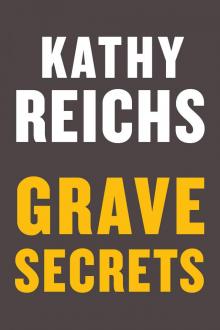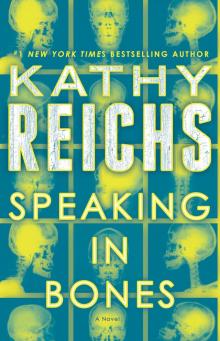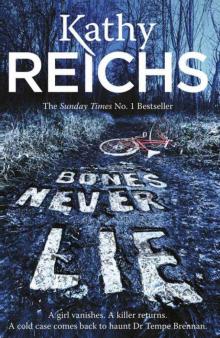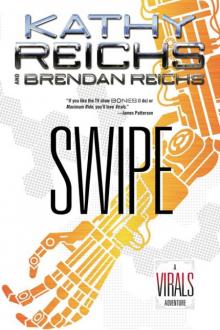- Home
- Kathy Reichs
Spider Bones: A Novel Page 8
Spider Bones: A Novel Read online
Page 8
We entered building 45 through a back door and followed a corridor past the general’s staff offices into the main lobby. On the walls, wood-mounted brass plaques named the fallen ID’ed through JPAC efforts.
Danny swiped his badge at a pair of glass doors and we entered the CIL public area. To the left, a long glass wall provided a view of the main lab. Before it, a folding table held skulls, bones, and military equipment used for demonstration purposes.
Straight ahead a hallway led to offices, a copy center, a small kitchen, a conference room, and an autopsy area used for artifact cleaning and analysis. Ahead and to the right, a counter was manned by a young man in army fatigues. Above his shaved head, analogue clocks indicated the hour in five time zones.
The offices of senior JPAC personnel ringed the perimeter. Only two doors stood open.
Roger Merkel is tall, slightly stooped, and balding. Well north of fifty, his face is tanned and scoured with lines from years in the sun.
Merkel was at his desk. Seeing us, he rose and hugged me so tightly my eyes teared, momentarily blurring my view of his office.
Stepping back, I marveled, as usual, at Merkel’s orderliness. Files and papers sat in neatly squared stacks. Books, photos, and mementos hung and stood in perfect formation.
After a few words with Merkel, Danny and I went in search of coffee. Gus Dimitriadus, a CIL anthropologist, was leaving the kitchen as we entered.
Though similar in age to Danny and me, Dimitriadus is someone with whom I’ve never felt a connection. He’s attractive enough, good hair, good eyes, but the guy acts like he lives on embalming fluid.
Gus Dimitriadus never laughs. Ever. Frankly, I’ve never liked him much.
Apparently others share my view. For as long as I’ve known him, Dimitriadus has lived alone in a small apartment near Waikiki Beach.
Dimitriadus looked up from the fax he was skimming. Seeing me, his perpetually dour face went stiff. With a nod, he continued down the hall.
Surprised, I turned to Danny. “What the hell?”
“Come on. You two have never been soul mates.”
“But we’ve always been cordial.”
“Don’t worry about it.”
Danny busied himself setting up mugs, dispensing coffee that resembled liquid asphalt.
I tried to think how long it had been since I’d seen Dimitriadus. Twelve years at least. He’d been deployed on missions the last few times I’d been to the CIL.
“Is Dimitriadus still peeved over the Kingston-Washington fiasco?”
Bernard Kingston died along with three others from a skimmer boat on the Mekong River in ’67. Thirty years later, four partial skeletons arrived at the CIL.
Long story. Short version, locals buried the seamen when they washed ashore, told their story in ’95, hoping for cash.
Dimitriadus caught the files. On review, I bonged his report, suspecting that two of the IDs had been reversed. Turned out I was right.
“Is that it?” I pressed.
Danny nodded.
“Jesus, that was ages ago.”
“What can I tell you?” Danny proffered a mug. “The guy’s a grudge holder.”
We passed no one else on the way to Danny’s office.
“Seems quiet.” I remembered a lot more hustle and bustle.
“A lot of folks are out in the field.”
Danny referred to workers away on recovery missions.
Quick primer on JPAC operations.
Once a loss incident case file has been opened and a likely body location has been pinpointed, an investigative team, or IT, is deployed to the scene. Could be anywhere—a rice paddy in Southeast Asia, a cliffside in Papua New Guinea, a mountaintop in the Himalayas, an underwater trench off the coast of Tunisia.
An IT is composed of ten to fourteen people, led by a team leader and a forensic anthropologist, the former responsible for the overall safety and success of the mission, the latter for the actual excavation. Other members include a team sergeant, linguist, medic, life-support technician, forensic photographer, and explosive ordnance disposal technician. Additional experts patch in as needed—mountaineering specialists, divers, and such.
Recovery sites range from a few square meters, as with single burials, to areas larger than football fields, as with aircraft crashes. The anthropologist kicks things off by laying out a grid with stakes and string, then, one by one, individual sections are dug. All soil is hand-sifted to maximize retrieval of the tiniest skeletal bits or fragments of associated artifacts. Depending on circumstances, a handful or a hundred local workers may be hired for a project.
Once everything’s back at the CIL, the lab rats gear up, examining bones, teeth, and material evidence and correlating all findings with historical records.
The anthropologist constructs as complete a biological profile as possible, analyzes trauma, and describes pathological conditions such as arthritis or old healed fractures. The odontologist compares recovered dentition to X-rays, handwritten charts, and treatment notes in antemortem records. Each collects a sample for mitochondrial DNA testing.
Material evidence varies from case to case. Aircraft data plates. Ordnance or weapons. Packs, mess kits, uniforms. Life-support equipment. Personal effects, such as rings, watches, or combs. Every shred, splinter, and chip is scrutinized.
As you can imagine, all this research, recovery, and analysis is labor-intensive, and an identification may take years for completion. If mtDNA is obtained from the bones or teeth, the search for family reference samples can add more time to the process.
Even then it’s not over. Every positive ID requires review at multiple levels, including external study by independent experts. That’s where I came in. For years I evaluated dossiers, dissecting the overlapping lines of evidence relevant to a particular set of remains.
Seems like beaucoup bother and bucks, you say? Trust me. The effort and expense pay off. On average, JPAC identifies six individuals each month. To date, more than 1,400 military personnel have been returned to their families. The gratitude of relatives is incalculable.
Bottom line, our troops know: should they march off to war, one way or another, we’re bringing them home.
“How many recovery missions are deployed each year?” No longer affiliated with JPAC, I hadn’t a sense of current numbers.
“At least ten in Southeast Asia, maybe five associated with the Korean War.” Danny twisted his lips in thought. “Ten others wherever, you know, for World War II cases, or the Cold War. Teams are always coming or going.”
Danny’s office was the polar opposite of Merkel’s. Papers and books lay scattered about, files threatened to topple from unsteady stacks. Mementos lay tossed where they’d landed coming through the door. A signed softball. A kite. A photo of Danny digging on a mountain.
The desk held a similar array of memorabilia. A Micronesian sculpture made of what looked like pig tusks. A painted coconut. A miniature skeleton with Danny’s face glued to the skull. A stuffed lizard whose species was a mystery to me.
Danny cleared files from a chair so that I could sit. Before my arrival, he’d laid out Spider Lowery’s file. Though familiar with the contents, we started there.
Working through the documents reminded me how much time I’d spent squinting at smeared carbon copies of forms, faded message traffic, and illegible script. Spider’s record review took an hour.
“You’ve been swabbed?”
Danny referred to the DNA sampling required of anyone entering the lab. No big deal, a Q-tip swipe of the inner cheek. Specimens are kept on file should contamination become an issue with an ID.
I nodded.
We crossed to the glass wall and Danny placed his badge over the sensor. The door clicked. We entered and wove through a maze of tables, some empty, some holding bones, toward a man in a red sweater seated at a desk at the back of the room.
The Lumberton remains had been accessioned as 2010-37. Danny presented his badge and requested the case by
number.
Red Sweater rose and pressed a button. Floor-to-ceiling shelving opened and he disappeared down a row. Moments later he reappeared with a long, white cardboard box.
I knew the routine. The remains would be assigned a specific table where they would be allowed to remain for thirty days. The transaction would be entered into the computer tracking system, and the location of the bones would be diagrammed on a blackboard on one wall of the room.
Danny swiped his badge, collected the box, and moved to the designated table. I followed.
We both gloved, then Danny gestured me the honors.
I lifted the cover.
The remains were as I remembered, skull shattered, lower arms and hands and both feet missing, cortical surfaces darkly mottled and covered by pink-white mold and charred muck.
Working silently, Danny and I reassembled what was left of the man so long buried in North Carolina. Skull. Torso. Arms. Legs.
When the skeleton was arranged anatomically, we ran inventory, with Danny naming bones and me recording. Though I’d done a preliminary assessment at Sugarman’s, his would be the analysis of record.
Inventory finished, he went through the same steps I’d followed at the funeral home. With the same findings.
The remains were those of a male who died between the ages of eighteen and twenty-five. Race remained elusive.
“Nothing to exclude Spider Lowery,” Danny said.
“And nothing to positively ID him.”
“Teeth are out.”
“We might spot root fragments when we X-ray. Or we could compare alveolar configurations.” I referred to the shape of the tooth sockets.
Danny shook his head. “The Form 603 is strictly narrative.”
Danny meant Lowery’s military dental record, typically containing diagrams, called odontograms, X-rays, and information about the patient’s care, identity of dentist, when, where, et cetera.
“Why no X-rays?” I asked. “Wasn’t every soldier given a dental exam at induction?”
“Theoretically, yes. If not at his or her induction center, maybe in boot camp, maybe in-country, at Bien Hoa Air Base, for example. But it didn’t always happen.”
“You’re suggesting Lowery slipped through the cracks?”
“Maybe. Here’s another possibility. Troops reporting to a new duty station often carried their own records with them. It helped with in-processing if medical and dental information arrived at the same time as the soldier.”
I saw where Danny was going. “But that didn’t always happen either.”
“No. Sometimes paperwork caught up later. Maybe Lowery’s records arrived in Vietnam after he was killed and his body was shipped home.”
“Any way to tell from the file if X-rays ever existed?”
“Not really. Say a soldier had a periapical or a bitewing done. The X-rays might have been attached to the folder using a two-hole punch. Or they might have been placed into a small manila envelope and added to the file loose. Either way, the films could be lost or misplaced.”
Sudden ominous thought. “Or deliberately removed?”
Something flicked in Danny’s eyes, vanished before I could read it.
“Meaning?” he asked.
“I don’t know,” I said.
“I suppose.” Danny lifted and gently scraped at a skull fragment, much as I’d done at Sugarman’s. “Fire damage.”
“Consistent with the reported chopper crash,” I said. “As are the missing hands and feet and the cranial fractures.”
“The biological profile, the trauma, the timing, the body recovery location. It all fit. Thus the ID at Tan Son Nhut back in sixty-eight.”
“Johnson, Dadko, and some writing-challenged medical officer shipped this guy home as Spider Lowery.”
“Weickmann.”
“What?”
“The medical officer’s name was Weickmann.”
“You could read that scrawl?”
“Years of practice.”
“Whatever. Prints from my Quebec floater say they were wrong.”
“Nam was exploding in sixty-eight. The system was overwhelmed.”
Indeed.
Early in the war, a single facility processed all Americans killed in Southeast Asia. When fatalities soared in the spring of ’67, it became apparent that the status could no longer be quo. Cramped and located in a congested part of the base, the Tan Son Nhut mortuary was inefficient, inadequate, and a hazard to health.
As a result, a second mortuary was opened at the Da Nang Air Base. Beginning in June 1967, remains recovered in the I Corps tactical zone went to Da Nang.
But the Tet offensive shot numbers into the biosphere. In February 1968, the two mortuaries processed roughly three thousand sets of remains, a total greater than for any comparable period to that point.
The upshot was the construction of a modern twenty-table facility on a new patch of ground at Tan Son Nhut. The new facility became operational in August 1968.
Spider Lowery’s Huey crashed at Long Binh in January of that year, shortly after Tet and eight months before the revamped Tan Son Nhut mortuary came online.
In the chaos of war, a mistake had been made.
At a little past one Danny and I took a break. Wanting to accomplish as much as possible that day, we passed up a nice lunch at the Officers Club or the Mamala Bay Golf Course in favor of a quick pizza at the BX. The food hole. There’s a reason for the nickname.
While driving back to the CIL, I called Katy. To describe her as unhappy would be like saying Nixon was a bit bummed by the tapes.
By two fifteen Danny and I were back with 2010-37. For the next two hours we scraped desiccated flesh and fabric from bone, a job I find excruciatingly tedious. And the smell is revolting.
Adipocere is a waxlike substance formed by the hydrolysis of fat during decomposition. I’d about had it when a small chunk of the stuff dropped into the sink from the fragment of upper jaw I was scrubbing. I watched water eddy around it, swirling bits away and down into the drain.
I shifted my gaze to the newly exposed facial architecture. None of the cheekbone survived, and the zygomaxillary suture was unremarkable.
I rotated the fragment.
The upper palate was broad, its intersecting sutures largely unfused.
I inserted my probe into one of the empty tooth sockets. Another crumb of adipocere popped free. My eyes followed its flight path into the sink.
The original chunk had now been reduced by half. I was returning my attention to the maxilla when something caught my attention, more a glint of light than a visual impression.
Reaching down, I scooped the remainder of the original chunk onto my glove. When I poked, the thing split into two halves.
An object lay glistening in my glove.
“WHATCHA GOT?” DANNY NOTICED ME STARING AT MY PALM.
I extended my hand.
Whipping off his glasses, Danny brought his nose to within inches of my find. Seconds passed.
“Flip her over.”
I turned the thing with my probe. “Look familiar?”
“Nope.”
“Think it’s something?”
“Everything’s something.”
“Profound.”
“Looks like metal. Where was it?”
“Enveloped in adipocere packing the basicranium, below the palate.”
“Good eye.”
“Thanks.”
“M’lady’s penchant for shiny things pays off. Let’s scope it.”
We did, at increasing powers of magnification.
The object was roughly five millimeters long by three millimeters wide by a millimeter or so thick, and appeared to be made of gold. Its shape was irregular, with a lopsided glob on one side and two tapering projections on the other.
“Looks like a duck with a wide-open beak.”
The image didn’t work for me.
I rotated the thing ninety degrees. Danny took another turn squinting through the eyep
iece.
“Now it’s a mushroom with two pointy stems.”
I looked. “I can see that. Any idea what it is?”
“Not really.”
“A chip from a filling or crown?”
“Ehhh.” Danny scrunched his face.
“What? Ehhh?”
“Looks too thin and too flat.”
Danny’s eyes flicked to the wall clock. Mine followed.
Five forty-five. I hadn’t noticed the lab grow quiet. Or realized we were now alone.
“Quitting time?” I asked, knowing the answer.
Though Danny had been married almost twenty years now, he and his wife still coochie-cooed like newlyweds. At times I found their giddy-gooey-bliss act irritating as hell. Mostly I envied them.
“Quitting time.” Sheepish grin. Or horny. Or hungry. “Aggie’s making Salisbury steak.”
Danny sealed the mushroom-duck thing inside a baggy. Back in his office, he locked it in a desk drawer.
“Tomorrow we can pick Craig’s brain.” Craig Brooks was one of the three CIL dentists.
After removing our lab coats we headed out, Danny toward beef and gravy in Waipio, I toward gloom in Lanikai Beach.
Katy was on a lounge chair by the pool. I took a moment to observe her through the sliding glass door.
Katy wasn’t listening to her iPod, talking on her cell phone, surfing or blogging with her laptop. No book or magazine lay in her lap. Dressed in the same tank and drawstring pants she’d worn the night before, she simply sat staring out to sea.
In a word, she looked miserable.
Again I was swept by a feeling of helplessness. I knew only time would ease my daughter’s pain, and that a week had yet to pass since news of Coop’s death. I also knew the delivery of that news had been cold and impersonal.
Still.
Steeling myself, I exited to the lanai.
“How you doing, tough stuff?” A childhood endearment.
“Ready for the play-offs.” Flat.
“Where did you go today?” Dropping into the chair beside Katy’s.
“Nowhere.”
“What did you do?”
“Nothing.”
“Got any thoughts on dinner?”
“I’m not hungry.”

 Two Nights
Two Nights The Bone Collection: Four Novellas
The Bone Collection: Four Novellas Fatal Voyage
Fatal Voyage 206 Bones
206 Bones Bones to Ashes
Bones to Ashes Terminal
Terminal Monday Mourning
Monday Mourning Flash and Bones
Flash and Bones Cross Bones
Cross Bones Devil Bones
Devil Bones Break No Bones
Break No Bones Swamp Bones
Swamp Bones Déjà Dead
Déjà Dead Shock
Shock Spider Bones
Spider Bones Death Du Jour
Death Du Jour Grave Secrets
Grave Secrets Trace Evidence: A Virals Short Story Collection
Trace Evidence: A Virals Short Story Collection Bones on Ice
Bones on Ice The Bone Code
The Bone Code Bones in Her Pocket
Bones in Her Pocket Seizure:
Seizure: Speaking in Bones
Speaking in Bones Deadly Decisions
Deadly Decisions Spike
Spike Bones Never Lie
Bones Never Lie Bones of the Lost
Bones of the Lost Virals 03.5 - Swipe
Virals 03.5 - Swipe Exposure
Exposure A Conspiracy of Bones
A Conspiracy of Bones Shift (tory brennan)
Shift (tory brennan) Bones of the Lost: A Temperance Brennan Novel tb-16
Bones of the Lost: A Temperance Brennan Novel tb-16 Virals tb-1
Virals tb-1 Bones Are Forever tb-15
Bones Are Forever tb-15 Code tb-3
Code tb-3 Seizure tb-2
Seizure tb-2 Deadly Descisions
Deadly Descisions Spider Bones: A Novel
Spider Bones: A Novel